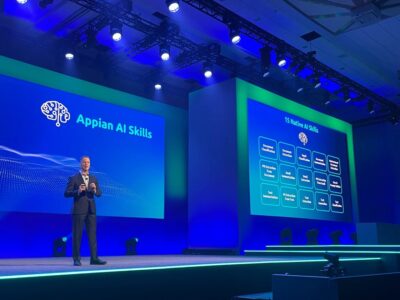There are times when Johnny Ray Austin comes to his Silver Springs home and just leaves his work bag at the door.
Work is the last thing he wants to think about when doing what’s most important to him: spending time with his wife and two kids, an eight-year-old and a two-year-old.
But that’s not to say the 32-year-old Austin hates his job as the director of technology at freshly-acquired iStrategyLabs — he loves what he does. So for him, leaving his work at the door is one small way he finds a good balance between work and family.
As ISL’s director of technology, he leads a team of engineers who build projects for companies like Facebook. Austin himself specializes in front-end web development and coding languages like JavaScript, Go and Python. Some of the big projects ISL has built include Facebook’s Mentions Box, which debuted in 2014 as a way for celebrities to answer fans’ questions with an immediate video response, as well as the more recent Levee tool, which ISL used in a marketing campaign for season two of Mr. Robot.
Besides family and work, the Michigan native also teaches classes at General Assembly, and he’s dedicated to the next generation’s education as an IT advisory board member for education nonprofit National Academy Foundation, as well as a tech advisor for the D.C. chapter of Black Girls Code.
We chatted with him about the first computer program he made at 19, his move from working in government agencies to startups and how his time at ISL has helped him trust people more. (Note that we conducted this interview before the recent announcement of iStrategyLabs’ acquisition by J. Walter Thomson.)
###
Could you give us a background on where you’re from, where you went to school and how you got into tech?
I grew up in Saginaw, Michigan, one of the old automotive-driven towns in Michigan. I ended up going to school in Alabama. My stepfather who raised me was really big on HBCUs (historically black colleges and universities) and I wanted to be an aerospace engineer initially. Tuskegee University was actually the only school at the time that offered an aerospace engineering program so I ended up going there. After my freshman year though, I kind of figured that aerospace engineering wasn’t really my thing, so I wanted to change it.
Computer science, for me, was actually a fluke accident — it was right after the big Napster bust and technology was pretty big on the scene. I’m really into music and it was the first time I was easily able to access music. That was appealing to me so that’s what really got me into technology, just the possibilities around the stuff. So I kind of just fell into computer science. I didn’t write my first program till I was 19 years old.
What was that first computer program about?
It was a program that calculated the area of a triangle, if I remember correctly. It was dead simple but, at the time, it was a foreign language for me. I still remember sitting down at the computer with my first assignment, looking at the screen and seeing symbols that I knew existed but had no clue what they meant. It was really, really weird and scary at the same time. For some reason, I can still picture myself sitting there and I can still picture some of the code.
How did you end up in the D.C. area?
I first accepted a job at Lockheed Martin my senior year of college. That’s what kind of brought me out here. I packed up everything and drove up to the Herndon area where I had friends working there. I started going through Lockheed’s Engineering Leadership Development Program, but after a while, I knew that really big corporate structures and government weren’t really my thing. I wanted to do something a little different.
So I went to the other side of the spectrum and started working at a startup in Georgetown called EverFi. I worked with them for a while, specifically on their platform and trying to introduce some real-time features there, front-end development, etc.
After that, I didn’t really know what I wanted to do next. So I decided to apply to iStrategyLabs because they have a variety of work so I’d be doing something different every few months, which was appealing to me. I was hired on as a senior front-end developer. About a year or so, I moved up to director of technology and that’s what I’ve been doing ever since.
Were you nervous about moving from a more secure government job to a startup?
It’s kind of weird because people who are in government and have clearances, they’re nervous about making the leap out because you’ll lose your clearances and benefits and stuff like that. That kind of held me back for a while.
Lockheed was my first job out of college so in my mind, that was the only work environment. In government, having a high clearance — and I had a high clearance — is your ticket to retiring, you know they’re not going to get rid of you. But I just wasn’t happy. I really hated my job. [Laughs.]
Becoming a director has shown me that I can be a lot more trusting in the things that happen here.
I was definitely a little worried. It wasn’t even a jump to a normal company. It’s a startup, so it could fail at any time, and then what? But it worked out for the best. At the time, I was young, so I thought, “If I’m not going to do it now, I’ll never do it.”
What have you been working on at ISL as director of technology?
We’re still a pretty small company, a little less than 80 people with the engineering team being around 17 people, but there’s still a lot of work to go around. A lot of what we’ve done in the last year and a half on the engineering team is revamp our view of the world. So we’re doing a lot more open source development stuff.
Our engineering blog is a big part of that. I was actually one of the people who really pushed for that. It’s one of the efforts that we have for making the engineering culture at ISL more transparent. In the past, people would be aware that there was probably someone doing technical work within ISL, but I think that a lot of work we were doing on the engineering side was not really appreciated. There’s actually a lot of hard work that going into the planning and executing of these projects, and we wanted to have an outlet to be able to talk about that stuff separate from the more marketing side of the company.
Three Major Reasons We Decided To Ditch AngularJS https://t.co/XHNOoRvDRF #javascript #dctech // cc @vuejs
— Johnny Ray (@recursivefunk) July 13, 2016
We also have the community engagement committee. Essentially it’s a group of people who are responsible for all the community activities that we perform here. We have a service week where we have different opportunities for people to participate in community service, whether it would be helping out at the soup kitchen or plant gardens in a school. So that’s a big part of what I do as well, just helping to serve on that committee.
Were there any difficulties in assuming more of a leadership role?
One of the biggest challenges when I first started was delegation. I had been an engineer my entire career so I was used to being able to go in and do everything myself but now I have to make a conscious effort to let other people do it, even if I’m not 100 percent sure they’ll succeed. Sometimes a failure is much more valuable than a success because you’ll learn something. Just as I was growing and was making mistakes, other people need to do that as well. So balancing all of that is still a challenge overall.
Other than that, it’s been really cool to help guide technical direction instead of just writing technical code in every single instance. It’s helped me to trust people a lot more and learn more about them, their limits and the stuff that they can do. They’re constantly surprising me about how they step up and it shows that I can be a lot more trusting in the things that happen here.
I know you’re involved in several other community efforts, like with the National Academy Foundation and Black Girls Code. Why?
I guess for a lot of reasons. D.C. is fortunate enough to have many groups that are dedicated to identifying the many gaps that there are in technology, in terms of the workforce. With Black Girls Code, it seemed like it was one that really addressed a very specific group of people — young women of color. That was one thing that really stood out to me.
And the other thing that I mentioned before, I didn’t write my first computer program till I was 19 years old. Technology is so much more ubiquitous now. If they have an interest, there’s no reason why a young woman can’t start programming at the age of seven. If I can just help one person discover what it takes and find out that they want to do this for the rest of their lives, then I’m happy with that.
What are you doing outside of work these days?
My wife and I used to really be into powerlifting, so we really want to get back into that. When we were dating, we used to go to downtown Silver Springs a lot and go to the movies. We’re big sci-fi geeks.
Watching "Stranger Things" per @DarienJay100's suggestion – so far, so good!!
— Johnny Ray (@recursivefunk) July 24, 2016
I’m really into barbecuing these days. I make a mean rack of ribs on my smoker. Honestly, these days, I just really like spending time with my family, even if I’m just laying across the couch with my two-year-old jumping on my ribs like he was yesterday. To me, that’s heaven, that’s great.
Join the conversation!
Find news, events, jobs and people who share your interests on Technical.ly's open community Slack

DC daily roundup: Esports at Maryland rec center; High schoolers' brain algorithm; Power data centers with coal?

DC daily roundup: Tyto Athene's cross-DMV deal; Spirit owner sells to Accenture; meet 2GI's new cohort

DC daily roundup: $10M to streamline govt. contracting; life sciences might dethrone software; Acadia's new $50M

